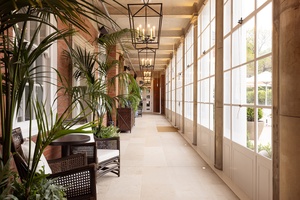
Fully restored Pearson House forms historic gateway to The Foundation
architecturenow.co.nz
Pearson House is part of The Foundation, a high-end retirement living project adjacent to Aucklands Domain. The villages first building, the Peddlethorp-designed Nathan Residences, opened to residents in October last year and work is currently underway on a second building, AbbottResidences.Pearson House colonnade.Image: SuppliedThe $17-million upgrade of the neo-Georgian Pearson House involved bringing the original colonnade back to life, linking the drawing room and a reading room and establishing a caf on the ground level. Upstairs has been redesigned to house a small cinema, billiard room, lounge, art studio, cardio studio and wellbeingsuite.The Foundation is a partnership betweenGenerus Living Group Limited and Foundation Properties Limited, the property-owning subsidiary of Blind Low Vision NZ, previously known as The Royal Foundation of the Blind. On completion in 2028, The Foundation will be home to an estimated 250 residents, with development costs at approximately $500million.Generus Living director Graham Wilkinson says Pearson House will serve as The Foundations private club. As a heritage property, Pearson House holds significant cultural value that represents a tangible link to the past. By undertaking conservation work, this remarkable property can bemaintained.Wilkinson says the company is committed to sustainable development and building villages which complement their natural surroundings. At The Foundation, contemporary buildings have been designed to complement the various adjacent historic buildings, including Pearson House and the JubileeBuilding.Interior designersMacintosh Harris have drawn inspiration from the neo-Georgian architecture of Pearson House in creating the richly textured interiors. I imagined how one would journey through the circulation spaces, and how that should be an uplifting experience, with bursts of light and colour along the journey, says Stewart Harris. This has been achieved with the use of colour, attention to lighting with crystals and chandeliers, and furniture inspired by the greats of 18th-century furniture makers. This, combined with selected wallcoverings and artworks, links the old with the new, creating a collection of the contemporary and thetraditional.Pearson House Maddington Room.Image: SuppliedSalmond Reed Architectsadvised on design development and the structural upgrading of Pearson House, particularly around seismic strengthening measures to determine more suitable solutions which were sympathetic to its heritagevalues.The buildings seismic upgrade involved removing four chimneys that penetrated through the roof plane, dissembling them and freighting the original bricks to Christchurch where they were slipped and reassembled onto lightweight, earthquake-safe chimneys, before being freighted back to Auckland and lifted back intoplace.Heritage New Zealand Pouhere Taongasenior conservation architect Robin Byron says neo-Georgian architecture was favoured in New Zealand during the 1920s and 1930s. Pearson Houses purpose-built design by Gummer and Ford, one of the countrys top architectural firms, helped ensure the blind were a constant public presence in the city and resulted in a building valued for its contribution to the Aucklandlandscape.History of PearsonHousePearson House is named after publisher Sir Arthur Pearson, the founder of St Dunstans in the United Kingdom, a facility for the rehabilitation of serviceman blinded in the First World War(19141918).The building consists of a main block with two short wings, joined by an impressive front colonnade. The 50 men who lived there were housed in large dormitories and single rooms on the first floor. On the ground floor were dining and sitting rooms, one of which was often used for fundraising concerts. Easy access for the blind was an importantconsideration.The simple plan features one corridor at each main level with rooms adjoining. While some men lived there while receiving trade training, others were permanentresidents.The building was renamed in 1933 as a memorial to Sir Arthur Pearson and, until 1998, remained much the same as when first built, with the exception of the enclosure of thecolonnade.Pearson Housetimeline1890 Jubilee Institute for the Blind established1926 Pearson House completed1933 The building was renamed in 1933 as a memorial to Sir Arthur Pearson1982 Last resident moved out of Pearson House1983 Commercial space available to tenants. It was also head office to an entity called Bledisloe Estate Trust (BET), which subsequently became Foundation Properties Ltd. BET moved to the workshops building when Kaplan moved in 19981998 Converted to Kaplans International language school2024 Pearson House renovated by TheFoundation
0 Kommentare
·0 Anteile
·261 Ansichten


